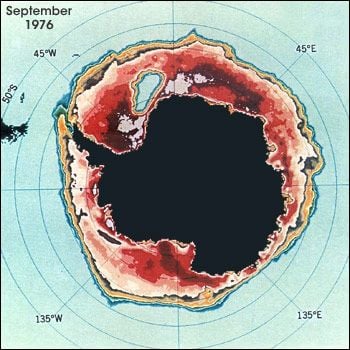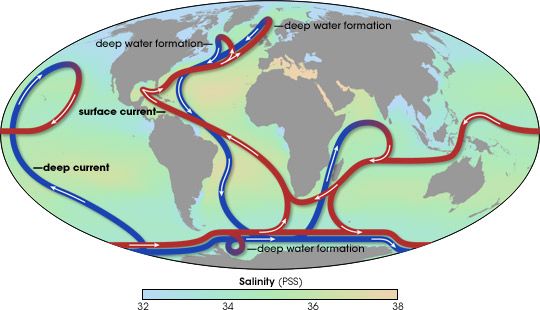Climate Change Felt in Deep Waters of Antarctica
A surge in freshwater at the surface may have shut down mixing of water layers in the Weddell Sea
/https://tf-cmsv2-smithsonianmag-media.s3.amazonaws.com/filer/14/ce/14ce7dff-ded6-4788-a7b5-8f2c72613967/antarctica_weddell.jpg)
In 1974, just a couple years after the launch of the first Landsat satellite, scientists noticed something odd in the Weddell Sea near Antarctica. There was a large ice-free area, called a polynya, in the middle of the ice pack. The polynya, which covered an area as large as New Zealand, reappeared in the winters of 1975 and 1976 but has not been seen since.
Scientists interpreted the polynya’s disappearance as a sign that its formation was a naturally rare event. But researchers reporting in Nature Climate Change disagree, saying that the polynya’s appearance used to be far more common and that climate change is now suppressing its formation.
What’s more, the polynya’s absence could have implications for the vast conveyor belt of ocean currents that move heat around the globe.

Surface seawater around the poles tends to be relatively fresh due to precipitation and the fact that sea ice melts into it, which makes it very cold. As a result, below the surface is a layer of slightly warmer and more saline water not infiltrated by melting ice and precipitation. This higher salinity makes it denser than water at the surface.
Scientists think that the Weddell polynya can form when ocean currents push these denser subsurface waters against an underwater mountain chain known as the Maud Rise. This forces the water up to the surface, where it mixes with and warms colder surface waters. While it doesn’t warm the top layer of water enough for a person to comfortably bathe in, it's enough to prevent ice from forming. But at a cost—the heat from the upwelling subsurface water dissipates into the atmosphere soon after it reaches the surface This loss of heat forces the now-cool but still dense water to sink some 3,000 meters to feed a huge, super-cold underwater ocean current known as Antarctic Bottom Water.
Antarctic Bottom Water spreads across the global oceans at depths of 3,000 meters and more, delivering oxygen into these deep places. It’s also one of the drivers of global thermohaline circulation, the great ocean conveyor belt that moves heat from the equator towards the poles.

But for the mixing to occur in the Weddell Sea, the top layer of ocean water must become denser than the layer below it so that the waters can sink.
To find out what has been going on in the Weddell Sea, Casimir de Lavergne of McGill University in Montreal and colleagues began by analyzing temperature and salinity measurements collected by ships and robotic floats in this region since 1956—tens of thousands of data points. The researchers could see that the surface layer of water at the site of the Weddell polynya has been getting less salty since the 1950s. Freshwater is less dense than saltwater, and it acts as a lid on the Weddell system, trapping the subsurface warm waters and preventing them from reaching the surface. That in turn, stops the mixing that produces Antarctic Bottom Water at that site.
That increase in freshwater is coming from two sources: Climate change has amplified the global water cycle, increasing both evaporation and precipitation. And Antarctic glaciers have been calving and melting at a greater rate. Both of these sources end up contributing more freshwater to the Weddell Sea than what the area experienced in the past, the researchers note.
To look at what the future might hold for this system, de Lavergne and colleagues turned to a set of 36 climate models. Those models, which predict that dry places of the world generally get drier and wet places get wetter, show that this area of the Southern Ocean should see even more precipitation in the future. The models don’t include melting glaciers, but those are expected to add more freshwater, which could make the lid on the system even stronger, according to the researchers.
A weakening of the mixing of water in the Weddell Sea could explain, at least in part, a shrinking in Antarctic Bottom Waters reported in 2012. “Reduced convection would reduce the rate of Antarctic Bottom Water formation,” says de Lavergne. That “could cause a weakening in the lower branch of the thermohaline circulation.”
That lower branch is the cousin to a similar process of convection happening in the Labrador Sea of the North Atlantic, where cold water from the Arctic sinks and drives deep currents south. If this source of deep water were shut off, perhaps because of an influx of freshwater, scientists have said that the results could be disastrous, particularly for Europe, which is kept warm by this movement of heat and water. Climate researchers consider this scenario highly unlikely but not out of the realm of possibility. And even a weakened system can have effects on climate and weather around the world.
More immediately, though, a weakening of the mixing in the Weddell Sea could be contributing to some of climate trends observed in Antarctica and the Southern Ocean. By keep warmer ocean waters trapped, the weakening may explain a slowdown in surface warming and expansion in the sea ice, the researchers note.
The weakening of the Weddell Sea mixing has also kept trapped all the heat and carbon stored in those deeper layers of ocean water. If another giant polynya were to form, which is unlikely but possible, the researchers warn, it could release a pulse of warming on the planet.
/https://tf-cmsv2-smithsonianmag-media.s3.amazonaws.com/accounts/headshot/Sarah-Zielinski-240.jpg)
/https://tf-cmsv2-smithsonianmag-media.s3.amazonaws.com/accounts/headshot/Sarah-Zielinski-240.jpg)